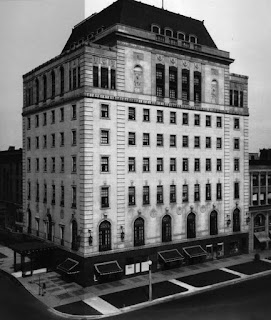The
Woman’s Athletic Club of Chicago, celebrating its 115th anniversary
in 2013, has deep Prairie Avenue
roots. Its founding can be traced back
to a dinner party at the home of Mrs. Philip D. Armour at 2115 S. Prairie Avenue, and many of the
early members and supporters were residents of the street as well. On March 9th, the museum offers
the exciting opportunity to tour the beautiful Club building completed in 1929
at 626 N. Michigan Avenue, including the elegant public spaces, as well as
rarely seen behind-the-scenes spaces, truly an upstairs-downstairs
experience. For further information on
the tour, call 312-326-1480. Group size is strictly limited.
The idea
for a Club where women could exercise and enjoy a leisurely meal with friends
originated with Mrs. Paulina Harriette Lyon.
One night, while dining at the home of Mr. and Mrs. Philip D. Armour,
she described her vision of the club.
Mrs. Belle Ogden Armour found the idea most intriguing and an important
project for women of the city to undertake (unlike the men who thought it an
“excellent joke”), and soon after pledged $50,000 to put the project in
motion. Such an idea was entirely new; it would become
the first athletic club for women in the United States. The
Club was officially incorporated on September 13, 1898 and Mrs. Armour was elected
president. Several of Mrs. Armour’s
neighbors quickly joined, including members of the Allerton, Caton, Drake,
Hutchinson, Lowden, Pullman,
Pike, and Smith families, and nationally prominent women such as Susan B.
Anthony, Julia Ward Howe, and the wife of President McKinley accepted honorary
memberships.
The first
home for the Club consisted of three floors in a six-story building on Michigan Avenue north
of Adams (now the site of the Peoples Gas Building). The official housewarming took place May 24, 1899 and it would remain
the home of the Club until 1909, when they moved to larger quarters in the
recently constructed International Harvester building at 606 S. Michigan Avenue (where John
Glessner had his office). It was in
that same year that Belle Armour was made honorary president for life (she died
in 1927).
The Club
had long dreamed of a building of its own and the opportunity came in the late
1920s when a site became available at the northwest corner of Michigan Avenue and
Ontario Street. Architect Philip B. Maher, just 33 years old
at the time, was hired to design the building, and designer Marian Gheen the
interiors. North Michigan Avenue was undergoing a
major transformation at the time, so the move north was considered most
appropriate and timely. When the building was designated a Chicago landmark on October 2, 1991,
the report said in part:
The building’s architecture
illustrates the sophisticated urban ambience of North Michigan Avenue, as it was
originally planned and developed in the 1920s.
The modern French-style classical design, which is reminiscent of
continental-style Parisian elegance, is one of the last standing links to the
street’s formative years.
The
building was dedicated and opened in April 1929, just a few months before the
Stock Market Crash and the start of the Great Depression. The Club struggled during those early years
in their new building, but a persistent and dedicated group of members ensured
its long-term survival, as other Clubs around them failed never to reopen.
Among the
more interesting furnishings are the chandeliers in the second floor gallery
and card room, made from two old gas chandeliers which once hung in the John B.
Drake home at 2114 S. Calumet
Avenue. The
nearby Ladies Powder Room contains several miniature rooms created by Mrs.
James Ward Thorne, a resident of 1708
S. Prairie Avenue and a friend of George and Alice
Glessner and Blewett and Frances Lee, who occupied the two houses immediately to
the north. The second floor also
features a portrait of founding president Belle Armour (shown below), painted in
1939 by Charles Sneed Williams.
Today,
the Club serves as a thriving link to our City’s past and continues to provide
an elegant oasis for its members amidst the hustle and bustle of North Michigan Avenue.



No comments:
Post a Comment